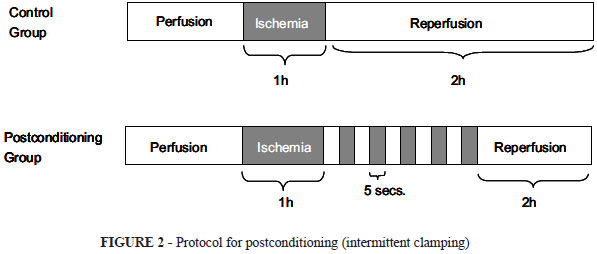PURPOSE: Liver ischemia-reperfusion injury is a phenomenon presents in events like liver resections and transplantation. The restoration of blood flow may leads to local and systemic injury. Several techniques have been developed in order to avoid or ameliorate ischemia-reperfusion injury in clinical situations. The application of a sttuter reperfusion after the ischemic event (postconditioning) could alters the hydrodynamics and stimulates endogenous mechanisms that attenuate the reperfusion injury. The present study was designed to evaluate the potential protective effect of postconditioning in a model of ischemia-reperfusion in rats. METHODS: Hepatic anterior pedicle of median and left anterolateral segments were exposed and clamped for 1 hour. Two hours later, clamp was released in two different ways: Control Group (n=7): clamp was release straightforward; Postconditioning Group (n=7): clamp was released intermittently. Lipid peroxidation (malondialdehyde) and expression of the glutathione-s-transferase-α-3 gene were studied. RESULTS: Lipid peroxidation was significantly decreased in ischemic and non-ischemic liver by postconditioning. GST- α3 gene was overexpressed in postconditioned group, but not significantly. CONCLUSION: Postconditioning induced hepatoprotection by reducing lipid peroxidation in the ischemic and non-ischemic liver.
Liver; Ischemia; Reperfusion; Lipid Peroxidation; Rats





